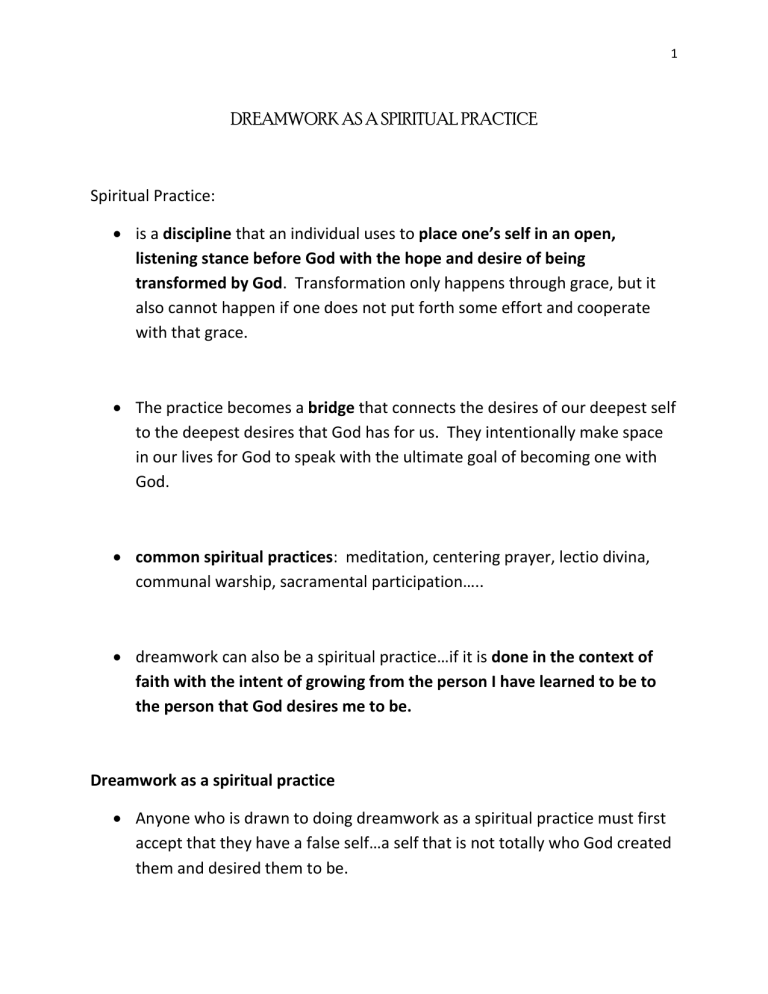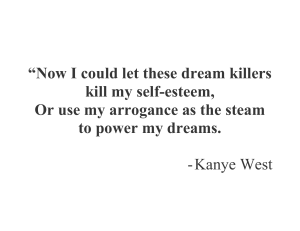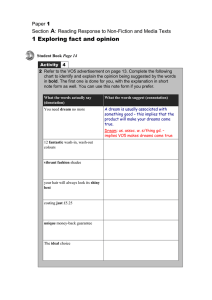
1 DREAMWORK AS A SPIRITUAL PRACTICE Spiritual Practice: is a discipline that an individual uses to place one’s self in an open, listening stance before God with the hope and desire of being transformed by God. Transformation only happens through grace, but it also cannot happen if one does not put forth some effort and cooperate with that grace. The practice becomes a bridge that connects the desires of our deepest self to the deepest desires that God has for us. They intentionally make space in our lives for God to speak with the ultimate goal of becoming one with God. common spiritual practices: meditation, centering prayer, lectio divina, communal warship, sacramental participation….. dreamwork can also be a spiritual practice…if it is done in the context of faith with the intent of growing from the person I have learned to be to the person that God desires me to be. Dreamwork as a spiritual practice Anyone who is drawn to doing dreamwork as a spiritual practice must first accept that they have a false self…a self that is not totally who God created them and desired them to be. 2 dreamwork as a spiritual practice has as its basis the desire and longing for a greater awareness of God – not merely to alleviate misery…which might be true when doing dreamwork is used in therapy; Bible from Genesis to the book of Revelation OT – 1) dreams inspired people to do things 2) they were interpreted by someone other than the dreamer For example: Jacob is inspire to action: Genesis 28: 10-22 Jacob’s Dream at Bethel – Jacob makes the promise Jacob’s son, Joseph, is the very famous dreamer and interpreter of dreams Genesis 40: 1-23 The Dreams Interpreted We hear of Abraham, Daniel and Samuel’s dreams, too. NT – Believed as their ancestors did: God reveals himself in dreams. Dreams are mentioned in Matthew, Acts, and the Letters of St. Paul. 3 Joseph -Of course we all know well Joseph’s dreams – in regards to marrying Mary, fleeing to Egypt for safety and returning to Israel when it was safe. …gospel writer wrote as if Joseph was literally following his dreams, but could it possibly be that he was just reporting the meaning of the deams after Joseph had grappled with it? – what is important to note is that Joseph paid attention to his dreams and acted upon them…Joseph recognized the message as coming from a higher authority than those who would have stoned Mary…it seems that no one shamed him for doing it either. Jesus— We don’t have access to Jesus dreams at night, but there is plenty of evidence that Jesus believed that the spiritual world broke into the physical world – J’s Baptism and the Transfiguration Jesus taught using parables. In other words he taught using symbols. He took ordinary things that the people could relate to teach…this is very much how dreams work. Acts of the Apostles Decisions are made based on dreams and visions o Acts 10 – through the symbols of his vision, Paul came to understand that Gentiles were alos welcomed to be Baptized. o Acts 16, 18,23, and 27 are all night dreams of Paul’s – each time receiving direction as to where he was to go preach Present understanding -- St. Thomas We have St. Thomas to thank for the initial break from seeing dreams as a means of opening ourselves up to the voice of God in our lives. Thomas 4 was highly influenced by Aristotle’s philosophy which taught that human experience was real only if it could be experienced through sensory perception and reason The field of psychology began to bring back the importance of paying attention to dreams beginning with Freud and his student, Jung. This is an ongoing development both in the psychological and spiritual realms Dream Research people must dream for their psychological, physical and emotional health; people who are consistently prevented from dreaming get ill dreams help us to keep an interior balance not everyone remembers their dreams, but we all dream typically we dream 4 to 7 times per night – as we sleep our brainwaves slow down o beta waves – full activity o alpha waves – unfocused relaxing activity o theta waves-- creative activities o delta waves – sound sleep in sound sleep we move between theta and delta waves sometimes referred to as REM and non-Rem sleep – our most sound and restful sleep comes during non-REM sleep dreams happen during REM 5 o it is believed that our last dreaming period of the night is the most important and holds the wisdom of all of the other dreams o dreams are like a whole new world happening inside of us while our body rests; sometimes this world seems very strange and nonsensical – because our dreams come to us in a symbolic language – o Sanford, a well known writer on dreams and spirituality calls our dream language an “as if” language -- much like Jesus taught using parable. For example: The kingdom of God is like a mustard seed. Jesus wasn’t saying the kingdom was a mustard seed…but it symbolized the kingdom our dreams rarely if ever are literal – they take images we know and are trying to teach us something we don’t know on a conscious level The purpose of dreams it seems is to communicate from the unconscious part of ourselves to the conscious part of ourselves. Our unconscious holds things we have forgotten, repressed or denied. It is filled with unseen energies and is the source of much of our thought, feeling and behaviors. Though we aren’t aware of it, all we hold in our subconscious has a huge impact on our conscious behavior. The more we can bring our unconscious to consciousness the closer we can live the full potential God gave us. o Jung, by comparing thousand of dreams came to understand there is a personal unconscious and a collective unconscious 6 o personal unconscious-- JUNG’S WORDS: Everything of which I know, but of which I am not at the moment thinking; everything of which I was once conscious but have now forgotten; everything perceived by my senses, but not noted by my conscious mind; everything which, involuntarily and without paying attention to it, I feel, think, remember, want and do; all the future things which are taking shape in me and will sometime come to consciousness. o collective unconscious – part of our psyche that hold the shared experience of all of humanity. Jung believed that each person was born with a common foundation that carries universal themes which run through life and which transcend cultures – like our bodies have a common structure so do our psyches o these common structures are referred to as archetypes; for example SHADOW is an archetype – there is a shadow or aspects that we are unaware of in each of us and we have yet to live out – that actual form of the shadow varies from person to person put generally appears as the same sex as the dreamer and is often an inferior or unwanted image; when we work with the shadow we often find that it is actually a gift to us and a welcome addition to our personality o the HERO is another archetype The hero, pursues a great quest to realize his/her destiny Few Things to Keep in Mind: 1. Dreams speak to us in symbols. Very few dreams can be interpreted literally 2. The significance of the symbols are rooted in our personal and collective unconscious. 7 3. Only the dreamer can say what a symbol means to him/her. 4. Typically every dream is about the dreamer. Though some familiar people or places appear in the dream, typically it is not about that place or that person. … look at personality traits, the state of your relationship to that person, or a play on a name. 5. Can’t look at every dream. Pay attention to the ones that have a lot of energy for you and those that occur at special times of the year. 6. Dreams always bring us to health and integration. They may feel frightening when we experience them, but in working through them they will always bring us to growth. 8 5 Step Approach to Working with Dreams as a Spiritual Practice Step 1: Writing the Dream Even if one does not have the time to work with a dream, the dream is still honored by having been written down. This is a communication to our subconscious that we are interested in listening and learning from it. The dream needs to be written in the present, as if it is happening right now. For example I would not write: In my dream I was driving my red car to the movies. But, I would write: In my dream I am driving my red car to the movies. Step 2: Making Associations Make a list each symbol in the dream. Every person, place, color, number, absolutely anything in the dream is a symbol. Go back to each symbol and write down any associations (word, idea, mental picture, feeling, memory or colloquialism) that the dreamer connects with it. There is no fool proof method to know when one has come to the meaning of the symbol. It is more of a gut or emotional knowing. Frequently there is an “aha” sensation or more energy around some association as compared to the others. Go with the energy. Jung referred to this as the “click” method (Johnson, 56). If nothing is triggered inside, then move to the next symbol and come back to it. 9 Step 3: Connecting with the Dynamics Connect the dream images and the associations we came to in step 2 to the inner dynamics of our lives. Keeping in mind that the vast majority of our dreams are about the dreamer, the dreamer needs to figure out how the dynamic that is happening in the dream is happening inside of him/her. Going back to the example of red saying the association that clicked is passion. In this step one would ask questions such as: Where is passion in me? Where am I experiencing passion? Where have I been passionate? Just as it was in steps 1 and 2, it is important to write down the connections we make to our inner dynamics. Sometimes the physical writing helps the connections to become clear and definite Step 4: Interpreting the Dream Only after the dreamer has made associations with each symbol, finding ones that created energy or brought about an aha and has connected the associations with what seems to be happening in his/her life, the dreamer is ready to articulate what the dream could possibly mean. To do this questions such as “What is the central, most important message that this dream is trying to communicate to me? What is it advising me to do? What is the overall meaning to my life? Or, what question is this dream asking of me? 10 If you find you can make different interpretations from the associations, write out all of the possibilities and see if that brings clarity and pay attention to which interpretation holds more energy for you. If you still aren’t sure there are a few principles that can help confirm or disprove the interpretation: choose an interpretation that shows something you didn’t know, avoid an interpretation that inflates your ego and avoid interpretations that shift responsibility away from yourself Step 5: Ritualizing the Dream All of the steps up to this point have engaged the mind. This step is really about engaging the physical. This is a key step to integrate the dream and the message that it holds into your conscious life. The ritual is most effective if it is physical, simple, solitary and silent (Johnson, 99). For example if the message of the dream is that your life needs some organization, choose one drawer to straighten out rather than trying to reorganize your whole life. Merely cleaning one drawer represents the inner attitude change that the dream is calling for. If you cannot think of a physical ritual that goes with the dream, then do something in honor of the dream, like consciously eating an apple with the attitude and awareness that the action is to honor the dream. Many people, especially those of us in the West, have a tendency to want to keep everything at the head level. It is extremely important that we move our dream experiences to the emotional and gut level. Rituals do just that! 11 DREAMWORK AS A SPIRITUAL PRACTICE God told Aaron and Miriam, “Should there be a prophet among you, in visions I will reveal myself to him, in dreams will I speak to him Numbers 12:6 An uninterpreted dream is an unopened letter from God. The Jewish Talmud We acknowledge that God has given energy to our soul. In return, by doing dreamwork we consciously present to God the dream’s gift of our life energy. We offer back to the Source ourselves transformed by the energy, or grace, coming to us through the dream. We are graced in receiving the dream, and our dreamwork returns the dream, now transformed, as an offering to God. Dreams and Spiritual Growth: A JudeoChristian Way of Dreamwork by Savory, Berne and Williams Dreams come from our deepest truer self who desires and is struggling to be born and live in our conscious lives Dreams as Spiritual Direction by Don Bisson 12

